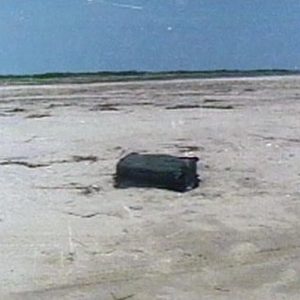A group of paleontologists found two fossilized skeletons of a race of tiny humans in the Whitmore Mountains, Antarctica. It is worth noting that these skeletons are up to 600 million years old.
Fossil bones of a race were found in the Whitmore Mountains, Antarctica. (Photo: t/h)
According to The National Reporter, a group of American paleontologists accidentally discovered these fossils while looking for evidence to prove that dinosaurs lived in Antarctica before the continent separated Africa and South America. America, then drifted south to its current location.
The fossils they found surprised them, beyond their imagination, not only because of their shape but also because of their time.
“We examined the fossils and determined that they are at least 600 million years old,” said Dr. Marly of Cambridge University, a member of the research team.
Dr Marly added: “The first skeleton we found was hidden deep inside the strata of a large sedimentary rock broken off from the mountainside. Given the type of rock and its age, we are certain that it most likely contains some chemical fossils.”

The first fossil skeleton they found was less than 30cm tall. (Photo via Archeology-world.com)
“When we opened the rock analysis, we were completely confused by what we saw. Therefore, at the time when vertebrate fossils appeared, this fossil was millions of years old. It is a complete set. Furthermore, it is a skeleton.”
“The second skeleton is a very good specimen for research. Unlike the first set, the second skeleton lies completely upright with an amazing level of detail.”

The second skeleton is very well preserved and shows other details. (Photo via Archeology-world.com)
Mr. Marly commented: “It is clear from our research data on these skeletons that we are definitely human and not a type of primate. Who they are, how large their population is, and whether their technological materials are advanced or not remain a mystery.”

The fossils were then transported to the Grand National Institute in Washington DC for further analysis.
The National Reporter also emphasized that these tiny fossil human skeletons are not the core of aliens.

If we follow Darwin’s theory of evolution, 600 million years ago jellyfish began to appear on Earth, when humans still did not exist. Even dinosaurs haven’t appeared yet. So why are there these strange human skeletons?

No way, this is not the first time human bones have been found on Earth. Previously, remains and relics related to this little owner were discovered in many places, making people surprised.
Other evidence about tiny people

Tiny human fossils were found in an abandoned city in the Atacama Desert in Chile. (Photo: siriusdisclosure.com)
In 2003, in an abandoned city in the Atacama Desert in Chile, Mr. Oscar Munoz discovered a tiny human skeleton with a strange shape, only 13 cm long.
The skeleton was then tested at Stanford University. The results showed that this tiny corpse was not a fake, nor was it a baby fetus, but belonged to a type of tiny human that no one had ever heard of.
The special thing is that this product is still completely intact, with a frame and internal organs such as lungs and a part of the body. Only the full control facility cannot be restarted. Test results show that this person has a life expectancy of about 6-8 years old.
Another case is that in 1932, Cecil Main and Frank Carr discovered a tremor while digging for gold in the San Pedro Mountains, Wyoming, USA. It was a dwarf found.
This determination sits upright, is about 18cm tall, has a natural skull, and dark skin. Based on the size and characteristics of this detail, some people believe that this may be a member of the legendary Nimerigar tiny tribe in America.
Identifying pygmies in the San Pedro Mountains. (Photo via Atlas Obscura)
Unable to identify the person at all, in 1946, Iranian archaeologists still found an entire city of dwarves dating back 5,000 years. This monument is located in the city of Shahdad, in Kerman province, Iran.
During the period 1948 – 1956, many attacks were conducted here. After enlightenment, people discovered many cemeteries, copper smithies, and countless ceramic and bronze objects from the 2nd and 3rd millennium BC.
In addition, the citadel also has many shops and residential areas in which jewelers, craftsmen and farmers live… More than 800 ancient tombs have been excavated.
The 17-year-old girl and her female friend have proven that 5,000 years have passed since they discovered each other again and again.
Panoramic view of Makhunik Dwarf City in Iran (photo: ISNA).
Remaining surveys reveal that the population moved away from the drought area 5,000 years ago and never returned.
After the service explores the dwarven city of Shahdad, but expands the news
Gửi ý kiến phản hồi
Bảng điều khiển bên
Các bản dịch đã thực hiện
Đã lưu





